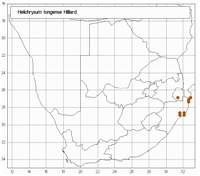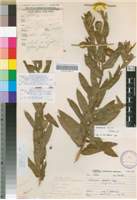Diagnostic characters:
Bright yellow bractsLarge solitary headsLeaf margins hairy
Description:
Herbaceous, probably biennial, up to 1.2 m tall, aromatic, stem forking, often low down, into long virgate branches, glandular-pubescent, loosely and thinly white-woolly at first, persisting on the upper parts, leafy. Leaves mostly 30�80 x 7�20 mm, smaller on the inflorescence branches, reduced near the heads, linear-oblong or oblong, apex acute, base broad, half-clasping, both surfaces glandular-pubescent, margins and sometimes the midline white-woolly. Heads heterogamous, depressed-globose, c. 12�14 mm long, (20�) 25�30 mm across the radiating bracts, solitary at the tips of long (mostly 50�300 mm) leafy branches corymbose-paniculately arranged. Involucral bracts in c. 9 series, graded, imbricate, inner much exceeding the flowers, glossy, bright yellow. Receptacle shortly honeycombed. Flowers c. 1000�1400, 100�340 female, 700�1200 homogamous. Achenes 1 mm long, barrel-shaped, glabrous. Pappus bristles many, equaling corolla, tips barbellate, bases with patent cilia, cohering or not.
Flowers mainly between January and June.
Distribution:
Grows in sandy grassland or open woodland, and becomes a weed in old fields. Nearly confined to the Tongaland plain, from about the Limpopo in Mozambique south to about Empangeni and Richards Bay in KwaZulu-Natal, with a few records from the Swaziland Lowveld.
Savanna Biome.
Notes:
Much confused with H. setosum but distinguished by its differently shaped leaves, persistently white-woolly ultimate branches and leaves much reduced near the heads.
Taxonomy:
Literature:
Helichrysum tongense Hilliard in Notes R. bot. Gdn Edinb. 40: 267 (1982), in Compositae in Natal 247 (1977) sub Helichrysum sp.
Type:
KwaZulu-Natal, Ingwavuma distr., Ndumu, Usutu floodplain, 20 ix 1968, Pooley 76 (NU, holo.; E, iso.).
Synonym(s):
Vouchers:
Bourquin 418 (NU); Gerstner 2724 (PRE); Lawson 503 (NH); Vahrmeijer 677 (PRE).

